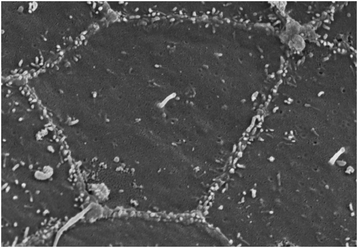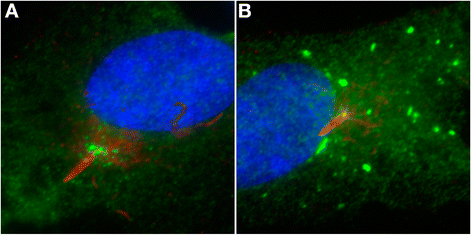The more we know, the more we have to discover: an exciting future for understanding cilia and ciliopathies
- PMID: 25974046
- PMCID: PMC4378380
- DOI: 10.1186/s13630-015-0014-0
The more we know, the more we have to discover: an exciting future for understanding cilia and ciliopathies
Abstract
The Cilia 2014 conference was organised by four European networks: the Ciliopathy Alliance, the Groupement de Recherche CIL, the Nordic Cilia and Centrosome Network and the EU FP7 programme SYSCILIA. More than 400 delegates from 27 countries gathered at the Institut Pasteur conference centre in Paris, including 30 patients and patient representatives. The meeting offered a unique opportunity for exchange between different scientific and medical communities. Major highlights included new discoveries about the roles of motile and immotile cilia during development and homeostasis, the mechanism of cilium construction, as well as progress in diagnosis and possible treatment of ciliopathies. The contributions to the cilia field of flagellated infectious eukaryotes and of systems biology were also presented.
Keywords: Basal bodies; Centrioles; Cilia; Ciliopathies; Development; Flagella; Hedgehog; Intraflagellar; Signalling; Transport.
Figures




Similar articles
-
Mechanism and Regulation of Centriole and Cilium Biogenesis.Annu Rev Biochem. 2019 Jun 20;88:691-724. doi: 10.1146/annurev-biochem-013118-111153. Epub 2019 Jan 11. Annu Rev Biochem. 2019. PMID: 30601682 Free PMC article. Review.
-
New insights into an old organelle: meeting report on biology of cilia and flagella.Traffic. 2014 Jun;15(6):717-26. doi: 10.1111/tra.12166. Epub 2014 Mar 29. Traffic. 2014. PMID: 24612344 Free PMC article.
-
Motile and non-motile cilia in human pathology: from function to phenotypes.J Pathol. 2017 Jan;241(2):294-309. doi: 10.1002/path.4843. J Pathol. 2017. PMID: 27859258 Review.
-
An age of enlightenment for cilia: The FASEB summer research conference on the "Biology of Cilia and Flagella".Dev Biol. 2016 Jan 15;409(2):319-28. doi: 10.1016/j.ydbio.2015.10.030. Epub 2015 Nov 17. Dev Biol. 2016. PMID: 26597000 Free PMC article.
-
Methods to Study Centrosomes and Cilia in Drosophila.Methods Mol Biol. 2016;1454:215-36. doi: 10.1007/978-1-4939-3789-9_14. Methods Mol Biol. 2016. PMID: 27514925
Cited by
-
xbx-4, a homolog of the Joubert syndrome gene FAM149B1, acts via the CCRK and RCK kinase cascade to regulate cilia morphology.Curr Biol. 2021 Dec 20;31(24):5642-5649.e5. doi: 10.1016/j.cub.2021.10.027. Epub 2021 Nov 2. Curr Biol. 2021. PMID: 34731674 Free PMC article.
-
Retinal disease in ciliopathies: Recent advances with a focus on stem cell-based therapies.Transl Sci Rare Dis. 2019 Jul 4;4(1-2):97-115. doi: 10.3233/TRD-190038. Transl Sci Rare Dis. 2019. PMID: 31763178 Free PMC article.
-
Assessing the Collective Dynamics of Motile Cilia in Cultures of Human Airway Cells by Multiscale DDM.Biophys J. 2017 Jul 11;113(1):109-119. doi: 10.1016/j.bpj.2017.05.028. Biophys J. 2017. PMID: 28700909 Free PMC article.
-
Human Brain Organoids to Decode Mechanisms of Microcephaly.Front Cell Neurosci. 2020 May 8;14:115. doi: 10.3389/fncel.2020.00115. eCollection 2020. Front Cell Neurosci. 2020. PMID: 32457578 Free PMC article. Review.
-
Murine Cep290 phenotypes are modified by genetic backgrounds and provide an impetus for investigating disease modifier alleles.F1000Res. 2015 Aug 20;4:590. doi: 10.12688/f1000research.6959.1. eCollection 2015. F1000Res. 2015. PMID: 26594343 Free PMC article.
References
-
- Bloodgood RA. From central to rudimentary to primary: the history of an underappreciated organelle whose time has come. The primary cilium. Methods Cell Biol. 2009;94:3–52. - PubMed
-
- Cole DG, Diener DR, Himelblau AL, Beech PL, Fuster JC, Rosenbaum JL. Chlamydomonas kinesin-II-dependent Intraflagellar Transport (IFT): IFT particles contain proteins required for ciliary assembly in Caenorhabditis elegans sensory neurons. J Cell Biol. 1998;141(4):993–1008. doi: 10.1083/jcb.141.4.993. - DOI - PMC - PubMed
LinkOut - more resources
Full Text Sources
Other Literature Sources

